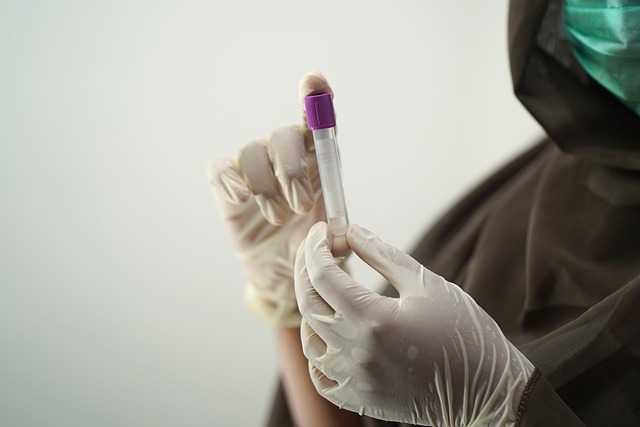The UK healthcare system incorporates comprehensive blood tests as a standard diagnostic tool for iron deficiency anemia (IDA), which is common and linked to inadequate iron reserves affecting hemoglobin synthesis. These tests include assessments of haemoglobin levels, ferritin, serum iron, and transferrin saturation to provide a complete evaluation of iron status. Given the heightened risk of anemia in diabetic individuals, which can affect glucose control and overall health, diabetes blood test UK protocols routinely include these measurements. Early detection of IDA is crucial due to its potential to lead to complications such as fatigue and compromised immune function. Healthcare providers use the results of these tests to guide treatment plans that may involve iron supplements or dietary changes to correct the deficiency and improve well-being, especially for diabetic patients who require regular blood testing for both their diabetes management and IDA monitoring. The UK's healthcare approach emphasizes the integration of IDA screening with diabetes care, utilizing a systematic process starting from symptoms recognized by a General Practitioner, through to specialized treatment and management guidelines provided by the NHS. This coordinated strategy ensures personalized care for patients with both conditions, leveraging integrated health records and accessible diabetic blood test UK services to deliver effective and timely treatment.
blood tests, iron deficiency anemia, detection, hemoglobin levels, ferritin, healthcare system, diabetes blood test, UK screening, anemia management
Iron deficiency anemia is a prevalent condition that can affect individuals of all ages. In the UK, detecting this condition early and accurately is crucial for effective management and treatment. This article delves into the pivotal role of blood tests in diagnosing iron deficiency anemia, emphasizing the importance of hemoglobin and ferritin levels as key indicators. Furthermore, it navigates the UK’s healthcare system, offering insights into screening processes and management strategies, including how these intersect with diabetes care and blood test protocols within the nation’s healthcare infrastructure.
- Decoding Iron Deficiency Anemia: The Role of Blood Tests in Diagnosis
- Understanding Hemoglobin and Ferritin Levels: Key Indicators in Iron Deficiency Anemia Detection
- Navigating the UK's Healthcare System for Iron Deficiency Anemia Screening and Management
Decoding Iron Deficiency Anemia: The Role of Blood Tests in Diagnosis

Iron deficiency anemia is a common condition characterized by insufficient iron stores to produce hemoglobin, a critical component of red blood cells that carries oxygen throughout the body. In the UK, reliable detection of this condition hinges on the analysis of blood samples, which are pivotal in diagnosing iron deficiency anemia. Blood tests measure various parameters including haemoglobin, ferritin levels, serum iron, and transferrin saturation, providing a comprehensive picture of an individual’s iron status. These tests are the cornerstone of diagnosis, enabling healthcare providers to differentiate iron deficiency anemia from other types of anemia, such as those associated with conditions like diabetes. In fact, diabetes blood test UK protocols often include these iron-related measurements due to the increased risk of anemia in diabetic patients, which can affect glucose metabolism and overall health. Early detection through these tests is crucial, as iron deficiency anemia can lead to a range of complications, including fatigue, weakness, and decreased immune function, making it imperative for individuals experiencing symptoms to undergo blood testing to ascertain the underlying cause of their condition. Healthcare professionals use the results from these tests to guide treatment plans, which may include iron supplementation or dietary changes to alleviate the deficiency and restore optimal health.
Understanding Hemoglobin and Ferritin Levels: Key Indicators in Iron Deficiency Anemia Detection

Understanding hemoglobin and ferritin levels is pivotal in the detection and management of iron deficiency anemia. Hemoglobin, a protein found in red blood cells, plays a crucial role in transporting oxygen throughout the body. It is a direct indicator of the overall health of one’s red blood cell mass and its ability to deliver oxygen effectively. In the context of diagnosing iron deficiency anemia, a low hemoglobin count can signal the presence of anemia. Similarly, ferritin levels serve as an important marker for assessing iron stores within the body. Ferritin is a protein that contains iron and its levels in the blood are closely monitored in clinical settings, as they reflect the amount of stored iron available to support hemoglobin production. A low ferritin level often indicates depleted iron reserves and can precede anemia, allowing for early intervention.
In the UK, diabetes management requires a comprehensive understanding of blood parameters beyond just glucose levels. The interplay between iron metabolism and diabetes is complex; iron deficiency anemia detection is not only relevant for anemia itself but also for individuals with diabetes, as it can affect glycemic control and the overall health of diabetic patients. Diabetes blood tests in the UK are thus expanded to include measurements of hemoglobin and ferritin. These tests are instrumental in both diagnosing iron deficiency anemia and monitoring its progression or treatment response, particularly in populations where diabetes is prevalent. Accurate detection through blood tests ensures timely diagnosis and effective management of iron deficiency anemia, which is vital for individuals with diabetes to maintain their health and well-being.
Navigating the UK's Healthcare System for Iron Deficiency Anemia Screening and Management

In the UK, navigating the healthcare system for iron deficiency anemia screening and management is a structured process that ensures individuals receive care based on clinical necessity. The first step typically involves a General Practitioner (GP), who will assess symptoms such as fatigue, paleness, or shortness of breath, indicative of iron deficiency anemia. If the GP suspects anemia, they will order a full blood count (FBC)—a standard diabetes blood test UK patients are familiar with due to its common use for diagnosing diabetes and checking overall health. The FBC can indicate if hemoglobin levels are below normal, suggesting anemia. Should the FBC suggest iron deficiency, further tests like serum ferritin or serum iron levels will be conducted to confirm the diagnosis. These tests measure the body’s iron stores and guide treatment. The UK’s National Health Service (NHS) provides comprehensive guidance on anemia management, including dietary recommendations and potential treatments such as iron supplements. Patients with confirmed iron deficiency anemia are then referred to a specialist if necessary, ensuring they receive the most appropriate care for their condition within the public healthcare framework.
For individuals with pre-existing conditions like diabetes, regular blood testing is integral for monitoring both their diabetic status and potential iron-related issues. The UK’s healthcare system facilitates this through integrated health records that can be accessed by authorized healthcare providers. This integration allows for a holistic approach to patient care, where diabetes management is closely aligned with anemia screening and treatment, ensuring that patients receive personalized care tailored to their specific health needs. Access to diabetic blood test UK services is a priority within the NHS, and patients are encouraged to seek medical advice if they experience symptoms suggestive of iron deficiency anemia alongside their diabetes management. Through this coordinated approach, the UK’s healthcare system aims to provide timely and effective care for those with iron deficiency anemia, including those with concurrent health conditions such as diabetes.
In conclusion, iron deficiency anemia is a condition that can be accurately detected through blood tests, which are instrumental in diagnosing and managing this health issue. Understanding hemoglobin and ferritin levels plays a pivotal role in the diagnosis process, as outlined in “Decoding Iron Deficiency Anemia: The Role of Blood Tests in Diagnosis.” These key indicators, along with other blood markers, provide healthcare professionals with essential information to identify anemia. Furthermore, navigating the UK’s healthcare system for iron deficiency anemia screening and management, as detailed in “Navigating the UK’s Healthcare System for Iron Deficiency Anemia Screening and Management,” is a structured process that ensures patients receive timely care. It is also notable that individuals with diabetes are at a higher risk of developing iron deficiency anemia, making routine blood tests crucial for this demographic within the Diabetes Blood Test UK framework. Regular monitoring and appropriate interventions can mitigate the health complications associated with this condition, thereby enhancing overall well-being and quality of life for those affected.
